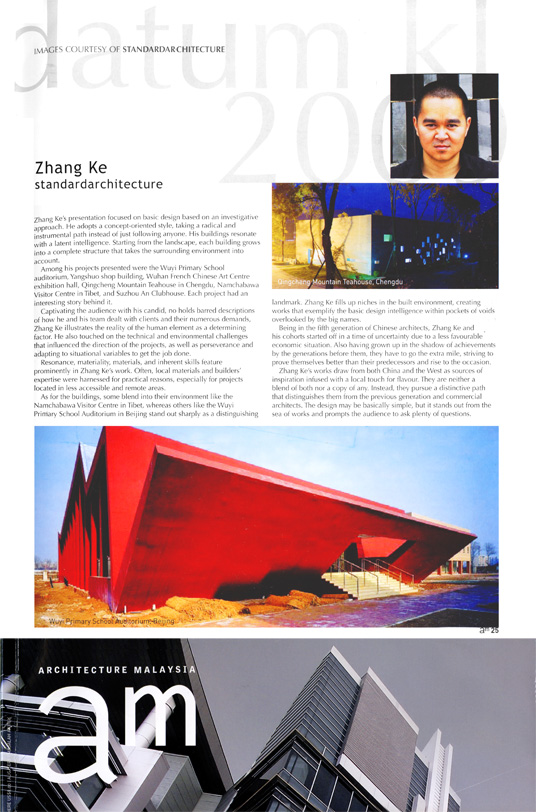Zhang Ke standardarchitecture
01 July 2009

Zhang Ke's presentation focused on basic design based an investigative approach. He adopts a concept-oriented style, taking a radical and instrumental path instead of just following anyone. His buildings resonate with a latent intelligence. Starting from the landscape, each building grows into a complete structure that takes the surrounding environment into account.
Among his projects presented were the Wuyi Primary School auditorium, Yangshuo shop building, Wuhan French Chinese Art Centre exhibition hall, Qingcheng Mountain Teahouse in Chengdu, Namchabawa Visitor Centre in Tibet, and Suzhou An Clubhouse. Each project had an interesting story behind it.
Captivating the audience with his candid, no holds barred descriptions of how he and his team dealt with clients and their numerous demands, Zhang Ke illustrates the reality of the human element as a determining factor. He also touched on the technical and environmental challenges that influenced the direction of the projects, as well as perseverance and adapting to situational variables to get the job done.
Resonance, materiality, materials, and inherent skills feature prominently in Zhang Ke's work. Often, local materials and builders' expertise were harnessed for practical reasons, especially for projects located in less accessible and remote areas.
As for the buildings, some blend into their environment like the Namchabawa Visitor Centre in Tibet, whereas others like the Wuyi Primary School Auditorium in Beijing stand out sharply as a distinguishing landmark. Zhang Ke fills up niches in the built environment, creating works that exemplify the basic design intelligence within pockets of voids overlooked by the big names.
Being in the fifth generation of Chinese architects, Zhang Ke and his cohorts started off in a time of uncertainty due to a less favourable economic situation. Also having grown up in the shadow of achievements by the generations before them, they have to go the extra mile, striving to prove themselves better than their predecessors and rise to the occasion.
Zhang Ke's works draw from both China and the West as sources of inspiration infused with a local touch for flavour. They are neither a blend of both nor a copy of any. Instead, they pursue a distinctive path that distinguishes them from the previous generation and commercial architects. The design may be basically simple, but it stands out from the sea of works and prompts the audience to ask plenty of questions.